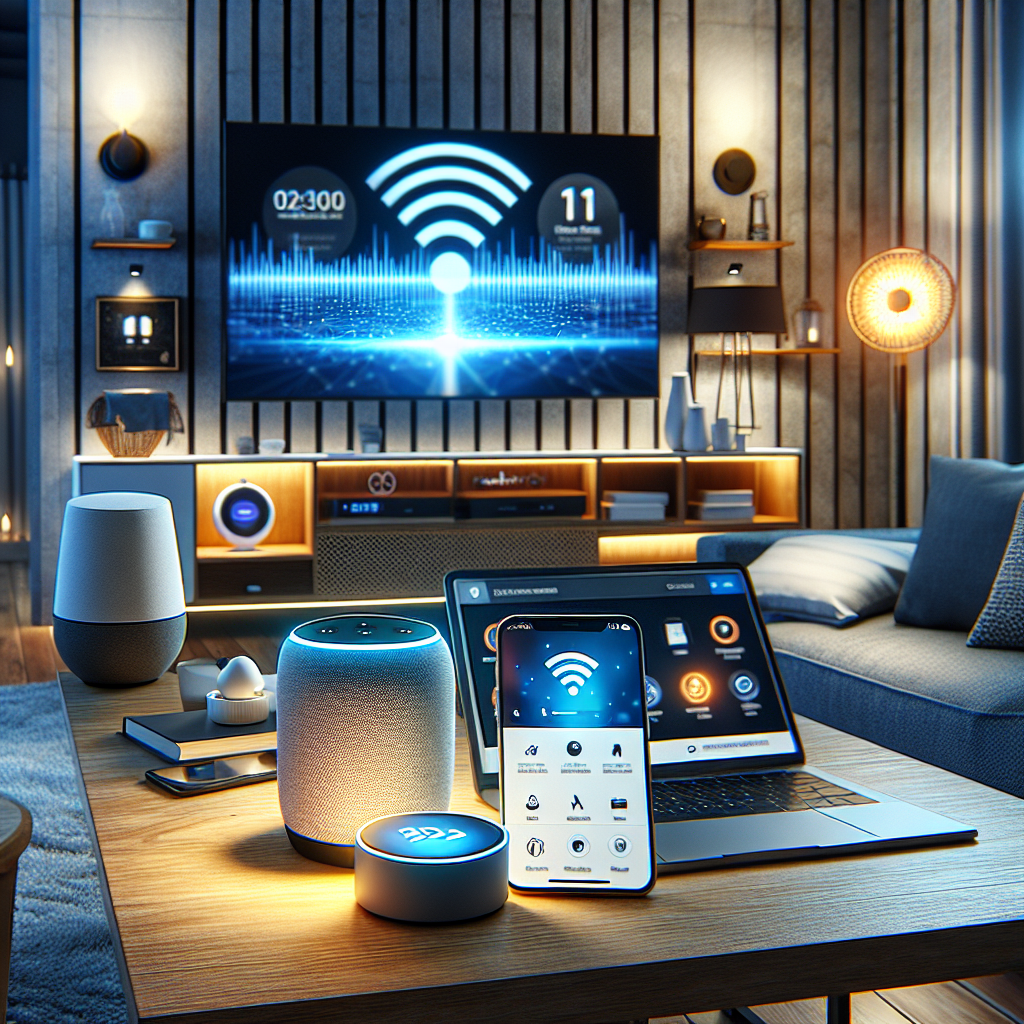In our modern world of connectivity, high-speed internet has become an essential component for the seamless operation of smart home devices. From smart speakers and thermostats to security cameras and lighting systems, these cutting-edge gadgets rely on a fast and stable internet connection to function effectively. With the rise of the Internet of Things (IoT), the demand for high-speed internet in households has never been greater. Join us as we explore the importance of reliable internet for smart homes and how it can enhance the efficiency and convenience of everyday living.
Understanding the Importance of High-Speed Internet for Smart Home Devices

Smart home devices are becoming increasingly prevalent in modern households, offering convenience, security, and efficiency. However, the optimal performance of these devices heavily relies on the quality and speed of the internet connection they are connected to.
Exploring the connection between high-speed internet and smart home device performance
- Smart home devices, such as thermostats, security cameras, and lighting systems, require a stable and high-speed internet connection to function seamlessly.
- High-speed internet ensures quick communication between the devices and the central control hub, enabling rapid response times and efficient execution of commands.
- In scenarios where multiple smart devices are interconnected, a high-speed internet connection prevents lags or delays in transmitting data, preventing disruptions in device coordination and automation.
Impact of internet speed on the functionality and efficiency of smart home devices
- Slow internet speeds can lead to delays in device response times, affecting the overall user experience and convenience offered by smart home technology.
- High-speed internet facilitates real-time monitoring and control of smart devices remotely, enabling users to manage their homes efficiently from anywhere.
- Video streaming, video doorbells, and security cameras especially benefit from high-speed internet, ensuring clear and uninterrupted video feeds for enhanced security and surveillance.
Types of High-Speed Internet Suitable for Smart Home Devices
Fiber Optic Internet
Fiber optic internet is a cutting-edge technology that uses thin strands of glass or plastic to transmit data at incredibly high speeds through pulses of light. This type of high-speed internet is particularly well-suited for smart home devices due to its numerous advantages and capabilities.
Benefits of fiber optic internet for smart home devices:
– Blazing-fast speeds: Fiber optic internet offers speeds that far surpass traditional broadband connections, allowing smart devices to communicate and function without any lag or delay.
– Reliability: Fiber optic cables are more durable and less prone to interference compared to copper cables, ensuring a stable and consistent internet connection for smart devices.
– High bandwidth: With fiber optic internet, smart home devices can easily handle data-intensive tasks such as streaming 4K videos, online gaming, and video conferencing simultaneously without any performance issues.
– Low latency: The low latency of fiber optic internet ensures that commands from smart home devices are executed almost instantaneously, resulting in seamless interactions and automation within the smart home ecosystem.
How fiber optic internet enhances the connectivity and responsiveness of smart devices:
– By providing ultra-fast speeds, fiber optic internet enables smart devices to communicate with each other and with external servers quickly and efficiently.
– The reliability of fiber optic internet ensures that smart home devices remain connected at all times, eliminating connectivity issues that may disrupt the functioning of the smart home system.
– The high bandwidth of fiber optic internet accommodates the increasing number of smart devices connected to the network, ensuring smooth operation and optimal performance for all devices.
– The low latency of fiber optic internet reduces response times for smart devices, enhancing their overall responsiveness and enabling seamless integration and automation within the smart home environment.
5G Home Internet
Types of High-Speed Internet Suitable for Smart Home Devices
In the realm of smart home technology, 5G home internet has emerged as a cutting-edge solution for optimizing the performance of various smart devices. Leveraging the power of fifth-generation wireless technology, 5G home internet offers a range of benefits that cater specifically to the demands of smart homes.
- Overview of 5G technology for smart homes
5G technology represents the latest evolution in wireless communication, boasting significantly faster speeds and lower latency compared to its predecessors. This high-speed connectivity is particularly advantageous for smart home devices, as it enables seamless data transmission and real-time responsiveness. By harnessing the capabilities of 5G, smart home ecosystems can operate more efficiently and effectively, enhancing the overall user experience.
- Advantages of 5G home internet in optimizing smart devices’ performance
One of the key advantages of 5G home internet for smart devices is its ability to support a multitude of connected devices simultaneously without compromising on speed or reliability. This is crucial in a smart home environment where numerous devices such as smart thermostats, security cameras, and voice assistants are constantly communicating over the network. With 5G, these devices can communicate with each other and with cloud services in a seamless manner, ensuring smooth operation and minimal lag.
Furthermore, the low latency of 5G technology is instrumental in enabling real-time interactions between smart devices, allowing for instantaneous responses to user commands. Whether it’s adjusting the lighting, streaming content, or monitoring home security, 5G home internet ensures that smart devices can deliver prompt and precise actions, enhancing convenience and usability for homeowners.

Challenges of Insufficient Internet Speed for Smart Home Devices
In the realm of smart home devices, the challenges stemming from inadequate internet speed are manifold and can significantly impede the seamless operation of these interconnected technologies.
Identifying common issues faced with slow internet connections
- Delayed Response Times: One of the most prevalent issues arising from sluggish internet speeds is the delayed response times when issuing commands to smart home devices. This lag can be frustrating and undermine the convenience that these devices are meant to provide.
- Intermittent Connectivity: Slow internet speeds often result in intermittent connectivity issues, leading to disruptions in the communication between smart home devices and the central hub. This can manifest as devices failing to respond, commands getting lost, or devices disconnecting unexpectedly.
- Buffering and Loading Delays: Streaming media content on smart home devices such as smart TVs or security cameras can be severely impacted by slow internet speeds, resulting in constant buffering, low-resolution playback, or extended loading times.
Consequences of inadequate internet speed on smart home device functionality
- Limited Device Compatibility: Some smart home devices require a minimum internet speed to function optimally. Inadequate speeds may render certain devices incompatible or restrict their features, diminishing the overall smart home experience.
- Security Vulnerabilities: Slow internet speeds can leave smart home networks vulnerable to cyber threats and hacking attempts. Without robust internet speeds, security protocols may not update in real-time, leaving devices susceptible to breaches.

– Inability to Utilize Advanced Features: Many smart home devices come equipped with advanced features that rely on high-speed internet connections, such as remote access, real-time monitoring, and data syncing. Insufficient speeds can limit the utilization of these features, compromising the full potential of the smart home ecosystem.
Tips for Optimizing High-Speed Internet for Smart Home Devices
When setting up a smart home, ensuring a robust and reliable internet connection is crucial for the seamless operation of various connected devices. Here are some tips to optimize high-speed internet for smart home devices:
- Placement of Wi-Fi Routers for Maximum Coverage and Signal Strength
Proper placement of Wi-Fi routers plays a vital role in ensuring optimal coverage and signal strength throughout the home. Position the router in a central location to reduce interference and maximize coverage. Avoid placing the router near thick walls or large appliances that may obstruct the signal. Elevating the router to a higher position can also help in extending the range of the Wi-Fi signal.
- Utilizing Mesh Networks to Enhance Internet Connectivity Throughout the Home
Mesh networks offer a practical solution to extend internet connectivity in larger homes or areas with dead zones. By using multiple access points that work together seamlessly, mesh networks can provide uninterrupted internet access across various devices. Investing in a mesh Wi-Fi system can help eliminate dead spots and ensure consistent high-speed internet for all smart home devices.
- Updating Router Firmware and Optimizing Network Settings for Improved Performance
Regularly updating the firmware of the router is essential to fix security vulnerabilities and enhance overall performance. Check for firmware updates from the router manufacturer’s website and install them promptly. Additionally, optimizing network settings such as channel selection, bandwidth allocation, and Quality of Service (QoS) settings can further improve the speed and reliability of the internet connection for smart home devices.
Future Trends in High-Speed Internet for Smart Home Devices
Advancements in internet technology for smart homes:
– 5G Integration: The integration of 5G technology into smart home devices is set to revolutionize the way these devices connect and communicate. With faster speeds and lower latency, 5G will enable seamless integration of various smart devices within a home network.
– Wi-Fi 6 Standard: The emergence of the Wi-Fi 6 standard brings with it improved efficiency in handling multiple connected devices simultaneously. This latest generation of Wi-Fi technology is designed to meet the increasing demands of smart homes, ensuring reliable and high-speed internet connectivity.
– Mesh Networking Solutions: Mesh networking solutions are gaining popularity in smart homes as they offer improved coverage and connectivity. By creating a network of interconnected nodes, mesh systems can enhance the reliability and speed of internet connections for smart devices throughout the home.
Predictions for the evolution of high-speed internet solutions for smart devices:
– Increased Bandwidth Demands: As smart home devices become more sophisticated and ubiquitous, the demand for high-speed internet bandwidth is expected to rise significantly. This will require internet service providers to develop and offer faster internet plans to meet the growing needs of smart home users.
– Integration of Artificial Intelligence: The integration of artificial intelligence algorithms into home networking equipment is expected to optimize internet performance for smart devices. AI-powered systems can dynamically allocate bandwidth based on device requirements, ensuring smooth operation of all connected devices.
– Focus on Security and Privacy: With the proliferation of connected devices in smart homes, there will be a greater emphasis on enhancing security and privacy measures in high-speed internet solutions. Future trends may include advanced encryption protocols and secure networking technologies to protect smart home devices from cyber threats.
Ensuring Security and Privacy with High-Speed Internet for Smart Home Devices
- Importance of securing smart home devices from cyber threats
In the realm of smart home devices, security is paramount to protect sensitive data and ensure the safety of individuals. With the proliferation of interconnected gadgets in modern homes, the potential vulnerabilities for cyberattacks have increased exponentially. Ensuring that smart home devices are safeguarded from malicious actors is crucial to maintain the integrity of the network and the privacy of users. High-speed internet connectivity amplifies these risks, underscoring the need for robust security measures to be in place.
- Implementing encryption protocols and security measures to safeguard data transmitted over high-speed internet
One of the fundamental ways to enhance security and privacy in smart homes is through the implementation of encryption protocols. By encrypting data transmitted over high-speed internet connections, the information becomes indecipherable to unauthorized parties, reducing the risk of interception and exploitation. Utilizing strong encryption standards such as AES (Advanced Encryption Standard) can fortify the communication channels between smart devices, ensuring that sensitive data remains confidential. Additionally, integrating security measures such as firewalls, intrusion detection systems, and regular software updates can further bolster the defense mechanisms against potential cyber threats. By employing a multi-layered approach to security, smart home users can mitigate the inherent risks associated with high-speed internet connectivity.
FAQs: High-Speed Internet for Smart Home Devices
What is the importance of having high-speed internet for smart home devices?
Having high-speed internet is crucial for smart home devices to operate efficiently and effectively. These devices require a stable and fast internet connection to communicate with each other and with the user’s smartphone or tablet. Slow internet speeds can result in lagging, buffering, and interruptions in the functionality of smart home devices.
What factors should I consider when selecting a high-speed internet plan for my smart home?
When selecting a high-speed internet plan for your smart home devices, consider the number of devices you have, the types of devices you own, and the activities you use the internet for. Make sure to choose a plan with enough bandwidth to support all of your devices simultaneously and to handle the data transfer requirements of streaming, gaming, and other high-bandwidth activities.
How can I optimize my high-speed internet for my smart home devices?
To optimize your high-speed internet for your smart home devices, consider placing your router in a central location in your home to ensure strong signal coverage. Use a dual-band router to separate your smart home devices from other devices on your network, and regularly update your router’s firmware to ensure optimal performance. Additionally, consider using a mesh network system for larger homes to ensure consistent coverage throughout your space.
What are some common issues that can occur with high-speed internet and smart home devices?
Some common issues that can occur with high-speed internet and smart home devices include network congestion, interference from other wireless devices, and compatibility issues between devices. Make sure to troubleshoot these issues by checking for firmware updates, adjusting your device settings, and ensuring that your network is secure and not being accessed by unauthorized users.